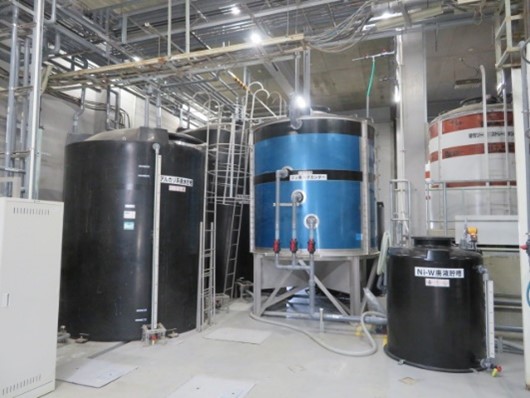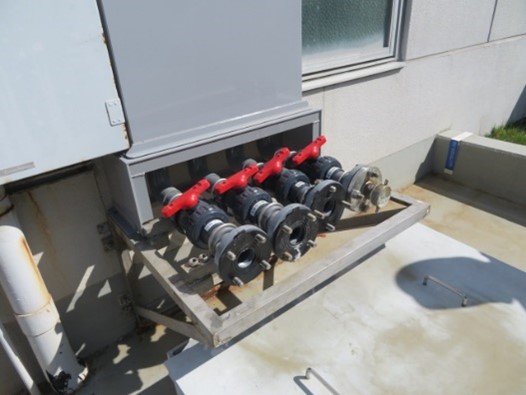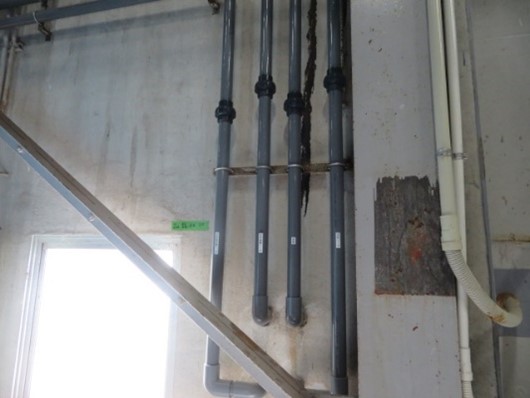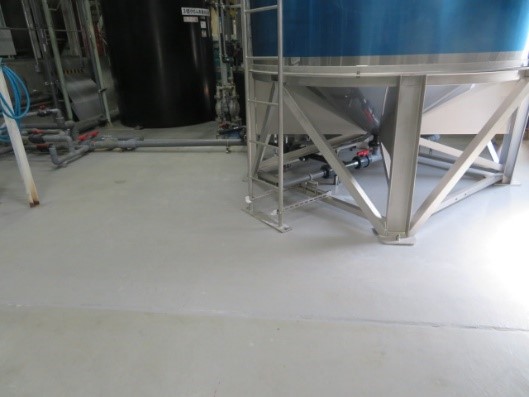Environmental Report 2023
Environmental Risk Management
The JAE Group identifies important environmental risks from external and internal issues, environmental impacts, environmental laws and regulations related to operations, etc., formulates a plan of action, and pursues countermeasures.Emergency Response
For tasks with a high risk of significantly affecting the environment, we have established emergency response procedures for each task, and we conduct procedure tests and drills as well as confirm procedure effectiveness.| Transfer of fuel from tank truck to fuel tank (discharge due to disconnection of hose, etc.) |
| Operation of waste gas scrubber (discharge of air pollutants caused by abnormality) |
| Use of harmful substances in plating process (leakage to floor surface, pits, etc.) |
| Storage of harmful substances in storage tanks (leakage/discharge due to damage) |
| Leakage of refrigerant chlorofluorocarbons from refrigerators and air conditioners |
Prevention of Soil and Groundwater Pollution
The discovery of soil and groundwater contaminated with hazardous substances is on the rise in Japan due to the redevelopment of former plant sites and voluntary surveys. Since countermeasures after contamination has already occurred take a vast amount of time and money, this is gaining recognition every year as a massive social problem, and related laws and regulations are being put in place.The JAE Group conducts risk assessments of its facilities that handle toxic substances and those associated with fuel oil, and takes countermeasures to prevent contamination, such as by double-walling underground storage facilities and pipes. This section introduces several activities to prevent contamination.
2010: JAE assessed risk of leakage and seepage into the soil with regard to its facilities that handle toxic substances and fuel oil-related facilities, then began to raise its underground pipes, installing them above ground (JAE Akishima Plant)
2013: The JAE Group commenced inspections with regard to the aging and useful lifespan of environment-related equipment and at facilities designated for storage of toxic substances, and regularly replaces the main valves on collateral pipes and other parts at proper intervals so as to reduce the risk of leakage. (JAE Akishima Plant)
2014: The above-ground installation of pipes, that had run underground, for toxic substances and those related to fuel oil, which had been assessed as high risk, was completed. Accompanying equipment upgrades to clean emissions generated in the plating process, the wastewater cleaning process tower's retainer walls were recoated. (HAE)
2015: In order to construct the Comprehensive Assessment and Testing Building, the former plant was demolished. Soil testing confirmed that there was no contamination. (JAE Akishima Plant, former site of No. 4 plant)
2018: Acid and alkaline treatment tanks were placed above ground and water pipes in the pit were replaced to prevent environmental pollution (HAE)
2019-2021: To further improve the environmental pollution prevention system, a portion of the underground storage tank of the wastewater treatment facility was moved above ground. The above ground move is expected to be completed in several years (HAE).
2021: The septic tank was updated to reduce the risk of soil contamination. (YAE).
2022: In the wastewater treatment building, decanters, pure water pumps, and chemical piping were upgraded to provide greater prevention against spills of hazardous substances and chemicals due to equipment damage and other factors. (HAE)



2022: The tanks for storing liquid waste after plating had new wastewater treatment piping installed and the floor surfaces were repaired to bring the piping above ground in 2023. (HAE)

Japan’s Water Pollution Prevention Act has established structural standards and mandatory periodic inspections of facilities that require the use of harmful substances to prevent groundwater contamination. Periodic inspections conducted by the JAE Group found no serious damage that could lead to contamination. Minor damage is repaired soon after discovery, and steps are being taken to mitigate risk.
Compliance with Environmental Regulations
The JAE Group has some 70 environmentally related regulations on record for which compliance status must be constantly ascertained. The Group periodically checks public bulletins from local and national government documents for revisions to the regulations it has on record. It also periodically conducts a study on the compliance status for mandatory notifications and reports.The following measures, which have been implemented since fiscal 2018, were continued in fiscal 2021 to further strengthen our legal compliance system.
- Standardization of the Group’s legal registration forms and compliance status survey forms
- Holding practical legal training for legal and regulatory research staff at each Group site to improve knowledge of laws and regulations
・Complying with Stricter Voluntary Standards for Air and Water Quality
| Air Pollution Control Water Pollution Sewerage Law Municipal ordinances |
The JAE Group has set its own voluntary standards for air and water quality. Its target values are about 20% below the maximum values allowed by the Japanese laws and regulations listed at left. |
Records of inspections of chlorofluorocarbon leaks in air conditioners, boiler inspections, and liquid nitrogen and other inspections were changed from paper records to tablet entry, and IoT shifts were promoted so that inspection work would be more efficient and irregular numbers can be confirmed quickly. (JAE Akishima Plant, SAE)
●Compliance Record for Fiscal 2022
In fiscal 2022, the JAE Group received no compliance-related notices or orders from government authorities for exceeding regulatory values in areas such as gas emissions, water discharge, noise and vibration. However, the Akishima Plant observed minor but perceptible excesses of SS values (standard value of less than 300 mg/L) and pH values (standard minimum value of 5.7; maximum value of less than 8.7) of sewer drainage. The cause was thought to be human sewage within the plant. The Akishima Plant has informed the local wastewater authority of Akishima City of the situation and is now pursuing corrective measures.
In addition, there was one occurrence of a delay in reporting the delivery status of waste management slips (manifests) at the JAE Akishima Plant. The cause was a lack of coordination between the parties involved and measures have been taken to prevent a recurrence.
●Act on Promotion of Resource Circulation for Plastics
Japan’s Act on Promotion of Resource Circulation for Plastics took effect in April 2022. This law is broadly relevant to businesses at every stage of the production and disposal of plastic products, and the JAE Group is one of the businesses required to comply with this law.Although the JAE Group has long promoted activities that are among the responsibilities required by this law, such as environmentally friendly design and zero-emissions activities, the Group will continue to advance these activities to comply with the law more appropriately.
| Sites | Manufacturers of plastic products | Specified plastic product providers | Waste producers | High-volume waste producers (Note) |
|---|---|---|---|---|
| JAE | applicable | - | applicable | - |
| HAE | - | - | applicable | applicable |
| YAE | - | - | applicable | - |
| FAE | - | - | applicable | - |
| SAE | - | - | applicable | - |
JAE Hirosaki (HAE) emitted 470.24 tons of "industrial waste from plastic products" in fiscal 2022, making the company a high-volume waste producer. The company has long worked to reduce and recycle waste plastic, which falls under the category of "industrial waste from plastic products," and is pursuing activities under the following targets for fiscal 2023.
| Targets | Key Measures |
|---|---|
| Reduction of molding material usage | Reduce the materials used by crushing and reusing (recycling) waste materials during molding |
| Reduction of molding materials discarded due to environmentally friendly design | Reduce the size of molds outside the area used for the product through environmentally friendly design |
| Conversion of waste materials during molding | Improve the conversion of plastic waste into a valuable resource |
Building a Sustainable World
Significance of the 2023 Environmental Report
Symbol of the Group's Environmental Policies
Scope of Reporting and Editorial Policy
Policies and Results of Environmental Activities
Environmental Management
- Implementation Status of the Environmental Management System
- Environmental Audits
- Environmental Education
- Environmental Risk Management
- Environmental Accounting
Engaging with Society
- Involvement with Biodiversity
- Supply Chain Management
- Eco-Friendly Products
- Social contribution activities
Initiatives to Reduce Environmental Impact